Well, I had an unexpected epic that I hope not to repeat. I made some mistakes. I’m trying to learn from them and figured I might as well share my experience.
I’m an experienced solo backpacker…but my experience is in the summer, winter, or at lower altitudes at that time of year. People with more experience in the shoulder season in the High Sierras and other high-altitude areas will just roll their eyes.
I started on a planned five-day trip to Dusy Basin, Palisade Basin, and nearby areas in the Eastern Sierras of California. Probably 2/3 of the time I planned to be on-trail. The average altitude was to be about 11,200 feet with an 12,000 foot Bishop Pass I’d cross a couple of times. The first and last days were to be solo. I had other folks on the permit, but two had to drop out. My friend Andrew remained but had time pressures that limited his time there. He’d meet me the next day after I updated him on the location of base camp.
The forecast looked good. Cold at night – maybe 20 degrees F, but warmer each night. There was to be perhaps .3 inches of snow from the day before. Cool! I didn’t think was a good way to get a reliable forecast for the location and altitude I was going to, so used a station 20 miles away and 1000 feet lower, and adjusted three degrees for the elevation change.
I left the trailhead with scattered ominous clouds and even saw a few drops of rain as I prepared to leave. FUN! I left my home in the SF Bay Area that morning where we don’t expect to see precipitation for months. This is the height of the summer there. The forecast looked good, right? I imagined the worst-case could be .3 inches of snow – the forecast for the day before when a little snow was expected. This day was supposed to be overcast, but dry. My gut was actually pretty nervous – it looked kinda gnarly. but was excited to get in. I silenced my gut voice.
I started seeing snow-pellets halfway into the 7.5 mile hike from the trailhead. I wasn’t overly concerned. The climb was about 3.1K feet of elevation change and was mostly non-technical. However, the 1000 feet of icy, three-foot-wide sun cups in the snow at the pass covered with a little snow from the day before lacked any contrast in the overcast and low visibility. I don’t carry trekking poles except in the winter so there were some falls in there. No problem. I dropped into Dusy Basin. The snow pellets turned into heavy snow. The hike up had taken 4.5 hours and it was 6:00. Sunset was in 45 minutes. I set up my tent, put on all my clothing, and got into my sleeping bag. I pinged my partner as well as the buddy who was to meet up with me the next day with with a Garmin Inreach. As I did so, the wind picked up. I checked the local forecast with the Garmin and got a “.3 inch of snow possible” response. But at that point it had already dropped 2-3 inches…in 15 minutes. I was getting pretty nervous. My gut finally got through from my subconscious to my conscious mind. I decided I didn’t come equipped for a heavy snowfall and I had no idea how much it was actually going to snow in this storm. I was concerned if I stayed overnight it might dump a couple of feet or more which would make trail-following back challenging.
Snow was blowing into my three-season UL tent through the mesh. I was already getting cold. Bad sign. No Bivvy. Not enough warmth margin in my sleep system. I was experienced with this system in the cold, and wet, but not with blowing snow that could lead to both. I figured I could hunker down and survive. I’d probably have to get up and move around from time to time since it was colder than I was prepared for. Would I get wet doing that? Probably. I could turn around and head back to the trailhead before the snow got too high. But that was obviously risky at night, right? I knew that I could physically do that in those conditions if I could stay on the trail. And not get injured. It would be a 15-mile day with about 6.2k feet of elevation change, but I was comfortable with that. But it was also going to be mostly in the dark and poor visibility. I didn’t have experience with that. I did have a map and compass and 2 devices with a breadcrumb trail I could reference for wayfinding. And I had a headlamp with backup lithium batteries that would work in the cold. And I knew I could stay dry and warm and do another 6 hours of hiking if needed in these conditions.
I chose to bail. I made the decision fast. Perhaps too fast. I notified my partner and my buddy who was planning to meet me the next day via Garmin, turned tracking on, and took off. When I got to the sun cups, they were already covered with a foot of snow. I fell several times which wasn’t fun at that altitude and in that context. My heart rate was in zone 3 for that whole section and closer on average to a mountain bike ride than a hike. I beat up my toe somewhere in the process, although I didn’t really notice it until the next day. I got turned around every time I fell in that snow field, and was pretty gassed out every time due to the altitude. At that point, I wasn’t sure I’d make it back, but I was too focused to linger on it.
After the pass and the more treacherous bits of the hike, I was pretty confident in success. But the path was getting tough to follow. I ended up checking my phone regularly to stay on the right track. It was running out of battery at that point, but it looked like I’d make it without recharging from my external battery if I kept up my current pace so I kept going. I finally got back to the trailhead at 10:00 at night, still dry and warm (except for my feet which were wet, but warm). I still had plenty of gas still in the tank (and my car’s tank). There was a foot of snow at the pass when I crossed it, and seven inches of snow at the trailhead. I bet there was two feet of powder at the pass by morning. I could have gotten through that the next day without snowshoes if I had chosen to hunker down, but I didn’t really know how much it was going to drop.
In my car, I plugged in my phone (that was almost out of juice) to top off and got a “your recharging slot is too wet for charging, dumbass!” notification which I didn’t know was a thing. I had a battery bank in my pocket if I needed to use it on the hike, but hadn’t known about the moisture problem even though I’d hiked with it in the rain and even snow many times before.
The road proved impassible for my vehicle, even with all-wheel drive, so I slept in my car. I was able to drive out the next day at 11:00 AM.
I made it out with a toe beat up from the ice field, and minor nerve damage to a thumb from the cold. I decompressed by camping in the nearby Alabama hills on BLM land in the Owens Valley 8,000 feet below with my buddy for a couple of warm, dry nights. I needed something comfortable and familiar.
It was 96 degrees inside my loft when I got home.
Where I failed:
- I didn’t bail at the signs of unpredictable weather when starting the hike even though my body was uncomfortable with how different it was from what I had expected.
- I didn’t adequately consider the likely margin of error for the conditions.
- I hung my decision-making on bad weather forecasts.
- I didn’t have enough margin for basic warmth and shelter.
What I learned:
- Safety margins should correspond to the margin of error for the situation at hand. UL isn’t about cutting to the bone, it requires sensible reserves. Those reserves can be smaller only with experience in the specific scenario.
- Just because you have a satellite communicator, and people know where you are, help can take a long, long time in bad conditions. Don’t let a lifeline alter your safety calculation.
- With lighting, trail-following at night wasn’t much harder than during the day. Snow cover is far more impactful.
- Inform logical decision-making with gut feelings. I’m not good at this.
- Invest in figuring out how to get usable weather forecasts for your specific location and altitude. It’s not going to be as easy as looking at wunderground, the closest weather stations, or other mainstream sources.
- Traveling with other folks may not improve a bad situation, but might keep you out of it. More heads offer more opportunities for someone to veto dumb choices.
- Consider logistics that allow for earlier starts from the trailhead, not just alpine starts from home when there’s a potential for poor conditions.
- My feet were warm on the hike in trail runners even though they went through the snow into running water a couple of times. Boots might have kept me from banging up my toe, but I still think I’d add gaiters before I added boots in the shoulder season.
What saved my ass:
- A headlamp with cold-rated batteries (had to be held off-axis by hand due to heavy snow in the air)
- Known fitness and endurance
- Devices leaving digital breadcrumbs to backtrack my path that had become covered with snow
- Strategic clothing layering strategy that enabled me to stay dry
In the future at that time of year, I’d add these to my equipment list:
- A two-wall tent and/or a bivy bag
- Warmer gloves
- Gaiters with Goretex trail running shoes
- A warmer sleeping bag
- Trekking poles
- A high-powered stove like my MSR Whisperlite Internationale
- A phone charging on the way in on an external battery (so it’s already fully charged if you need to bail)




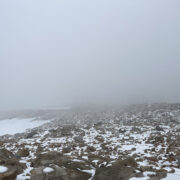
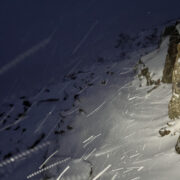
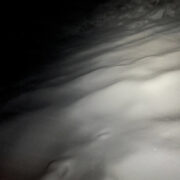
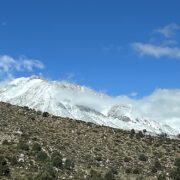

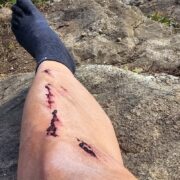
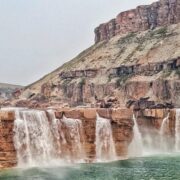



Home › Forums › Unexpected Snowstorm in the High Sierras: My Shoulder Season Lesson